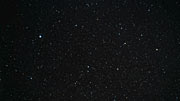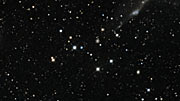Comunicato Stampa
Atomi per la Pace: una Collisione Galattica in Azione
10 Novembre 2010
Gli astronomi dello European Southern Observatory hanno ottenuto una spettacolare nuova immagine della famosa galassia Atomi per la Pace (NGC 7252). Questo tamponamento galattico determinato dallo scontro di due galassie, fornisce agli astronomi la possibilità di studiare come le fusioni tra galassie influenzino l'evoluzione dell'Universo.
Atomi per la pace è il curioso nome dato ad una coppia di galassie in interazione che si trova a circa 220 milioni di anni luce di distanza da noi, nella costellazione dell'Acquario. E’ conosciuta anche come NGC 7252 e Arp 226 ed è abbastanza brillante da essere vista dagli astronomi dilettanti come un piccolo e molto debole globo sfocato. Questa immagine molto profonda è stata prodotta dalla camera Wide Field Imager (WFI) installata al telescopio MPG di 2.2 metri dell'ESO a La Silla in Cile.
Le collisioni tra galassie sono tra i processi più importanti nell’influenzare il modo in cui evolve l’Universo, e il loro studio rivela importanti indizi sulle galassie primordiali. Fortunatamente, queste collisioni sono eventi molto duraturi nel tempo che si protraggono per centinaia di milioni di anni, fornendo agli astronomi molte occasioni per osservarli.
Questa immagine di Atomi per la Pace rappresenta un’istantanea della sua collisione, con il caos in piena attività, in uno scenario ricco di galassie lontane. I risultati di questo intricato gioco di interazioni gravitazionali possono essere notati nelle forme delle code composte da fasci di stelle, gas e polvere. L'immagine mostra anche gli enormi archi formati dal materiale di gas e stelle scagliato fuori dalle galassie a causa della collisione e che poi va a riavvolgersi attorno al nuovo nucleo comune. Mentre molto materiale è stato espulso nello spazio, altre regioni sono state compresse, scatenando intensi processi di formazione stellare. Il risultato ha prodotto centinaia di giovani ammassi stellari con età comprese tra 50 e 500 milioni di anni, che si ritiene possano essere i progenitori degli ammassi globulari.
Atomi per la pace può indicare una previsione del destino della nostra galassia. Gli astronomi prevedono che entro tre o quattro miliardi di anni la Via Lattea e la galassia di Andromeda si scontreranno, proprio come è successo con Atomi per la Pace. Ma niente panico: la distanza tra le stelle all'interno di una galassia è talmente vasta, che è improbabile che il nostro Sole finisca in un scontro frontale con un'altra stella durante la fusione.
Il curioso soprannome della galassia ha una storia interessante. Nel dicembre del 1953, il presidente degli Stati Uniti Eisenhower tenne un discorso chiamato Atomi per la Pace. Il tema era promuovere l'energia nucleare per scopi pacifici - un tema particolarmente caldo in quel momento. Questo discorso e le successive conferenze crearono una forte eco nella comunità scientifica e non solo, al punto che NGC 7252 fu chiamata la galassia Atomi per Pace. Per molti versi questo soprannome è curiosamente appropriato: la bizzarra forma che possiamo vedere è il risultato di due galassie che si fondono per produrre qualcosa di nuovo e grandioso, un po' come quello che si verifica nella fusione nucleare. Inoltre, gli anelli giganti ricordano proprio i diagrammi che nei libri di testo mostrano gli elettroni che orbitano attorno al nucleo atomico.
Ulteriori Informazioni
L’ESO (European Southern Observatory) è la principale organizzazione intergovernativa di Astronomia in Europa e l’osservatorio astronomico più produttivo al mondo. È sostenuto da 14 paesi: Austria, Belgio, Repubblica Ceca, Danimarca, Finlandia, Francia, Germania, Italia, Olanda, Portogallo, Spagna, Svezia, Svizzera e Gran Bretagna. L’ESO mette in atto un ambizioso programma che si concentra sulla progettazione, costruzione e gestione di potenti strutture astronomiche da terra che consentano agli astronomi di fare importanti scoperte scientifiche. L’ESO ha anche un ruolo preminente nel promuovere e organizzare cooperazione nella ricerca astronomica. L’ ESO gestisce tre siti unici di livello mondiale in Cile: La Silla, Paranal e Chajnantor. A Paranal, l’ESO gestisce il Very Large Telescope, l’osservatorio astronomico nella banda visibile più d’avanguardia al mondo. L’ESO è il partner europeo di un telescopio astronomico rivoluzionario, ALMA, il più grande progetto astronomico esistente. L’ESO sta pianificando al momento un Telescopio Europeo Estremamente Grande ottico/vicino-infrarosso di 42 metri, l’E-ELT, che diventerà “il più grande occhio del mondo rivolto al cielo”.
Contatti
Richard Hook
ESO, La Silla, Paranal, E-ELT and Survey Telescopes Public Information Officer
Garching bei München, Germany
Tel.: +49 89 3200 6655
Cell.: +49 151 1537 3591
E-mail: rhook@eso.org
Anna Wolter (press contact Italia)
Rete di divulgazione scientifica dell'ESO
e INAF-Osservatorio Astronomico di Brera
Milano, Italy
Tel.: +39 02 72320321
E-mail: eson-italy@eso.org
Sul Comunicato Stampa
| Comunicato Stampa N": | eso1044it |
| Nome: | NGC 7252 |
| Tipo: | Milky Way : Galaxy : Type : Interacting |
| Facility: | MPG/ESO 2.2-metre telescope |
| Instruments: | WFI |
Our use of Cookies
We use cookies that are essential for accessing our websites and using our services. We also use cookies to analyse, measure and improve our websites’ performance, to enable content sharing via social media and to display media content hosted on third-party platforms.
ESO Cookies Policy
The European Organisation for Astronomical Research in the Southern Hemisphere (ESO) is the pre-eminent intergovernmental science and technology organisation in astronomy. It carries out an ambitious programme focused on the design, construction and operation of powerful ground-based observing facilities for astronomy.
This Cookies Policy is intended to provide clarity by outlining the cookies used on the ESO public websites, their functions, the options you have for controlling them, and the ways you can contact us for additional details.
What are cookies?
Cookies are small pieces of data stored on your device by websites you visit. They serve various purposes, such as remembering login credentials and preferences and enhance your browsing experience.
Categories of cookies we use
Essential cookies (always active): These cookies are strictly necessary for the proper functioning of our website. Without these cookies, the website cannot operate correctly, and certain services, such as logging in or accessing secure areas, may not be available; because they are essential for the website’s operation, they cannot be disabled.
Functional Cookies: These cookies enhance your browsing experience by enabling additional features and personalization, such as remembering your preferences and settings. While not strictly necessary for the website to function, they improve usability and convenience; these cookies are only placed if you provide your consent.
Analytics cookies: These cookies collect information about how visitors interact with our website, such as which pages are visited most often and how users navigate the site. This data helps us improve website performance, optimize content, and enhance the user experience; these cookies are only placed if you provide your consent. We use the following analytics cookies.
Matomo Cookies:
This website uses Matomo (formerly Piwik), an open source software which enables the statistical analysis of website visits. Matomo uses cookies (text files) which are saved on your computer and which allow us to analyze how you use our website. The website user information generated by the cookies will only be saved on the servers of our IT Department. We use this information to analyze www.eso.org visits and to prepare reports on website activities. These data will not be disclosed to third parties.
On behalf of ESO, Matomo will use this information for the purpose of evaluating your use of the website, compiling reports on website activity and providing other services relating to website activity and internet usage.
Matomo cookies settings:
Additional Third-party cookies on ESO websites: some of our pages display content from external providers, e.g. YouTube.
Such third-party services are outside of ESO control and may, at any time, change their terms of service, use of cookies, etc.
YouTube: Some videos on the ESO website are embedded from ESO’s official YouTube channel. We have enabled YouTube’s privacy-enhanced mode, meaning that no cookies are set unless the user actively clicks on the video to play it. Additionally, in this mode, YouTube does not store any personally identifiable cookie data for embedded video playbacks. For more details, please refer to YouTube’s embedding videos information page.
Cookies can also be classified based on the following elements.
Regarding the domain, there are:
- First-party cookies, set by the website you are currently visiting. They are stored by the same domain that you are browsing and are used to enhance your experience on that site;
- Third-party cookies, set by a domain other than the one you are currently visiting.
As for their duration, cookies can be:
- Browser-session cookies, which are deleted when the user closes the browser;
- Stored cookies, which stay on the user's device for a predetermined period of time.
How to manage cookies
Cookie settings: You can modify your cookie choices for the ESO webpages at any time by clicking on the link Cookie settings at the bottom of any page.
In your browser: If you wish to delete cookies or instruct your browser to delete or block cookies by default, please visit the help pages of your browser:
Please be aware that if you delete or decline cookies, certain functionalities of our website may be not be available and your browsing experience may be affected.
You can set most browsers to prevent any cookies being placed on your device, but you may then have to manually adjust some preferences every time you visit a site/page. And some services and functionalities may not work properly at all (e.g. profile logging-in, shop check out).
Updates to the ESO Cookies Policy
The ESO Cookies Policy may be subject to future updates, which will be made available on this page.
Additional information
For any queries related to cookies, please contact: pdprATesoDOTorg.
As ESO public webpages are managed by our Department of Communication, your questions will be dealt with the support of the said Department.





